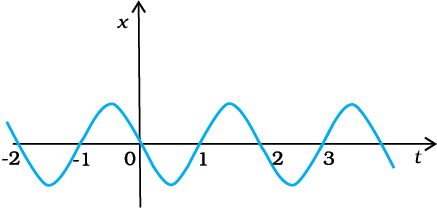Which one is not an example of a point object?
| 1. | A railway carriage moving without jerks between two stations. |
| 2. | A monkey sitting on top of a man cycling smoothly on a circular track. |
| 3. | A plane under a journey of several thousand kilometres. |
| 4. | A tumbling beaker that has slipped off the edge of a table. |
A drunkard walking in a narrow lane takes \(5\) steps forward and \(3\) steps backward, followed again by \(5\) steps forward and \(3\) steps backward, and so on. Each step is \(1\) m long and requires \(1\) s. There is a pit on the road \(13\) m away from the starting point. The drunkard will fall into the pit after:
1. \(37\) s
2. \(31\) s
3. \(29\) s
4. \(33\) s
The speed-time graph of a particle moving along a fixed direction is shown in the figure. Then the distance traversed by the particle between \(t=0\) s to \(10\) s is:
1. \(70\) m
2. \(60\) m
3. \(50\) m
4. \(40\) m
The velocity-time graph of a particle in one-dimensional motion is shown in the figure. Which of the following formulae is correct for describing the motion of the particle over the time interval \(t_1\) to \(t_2?\)

| 1. | \(x\left(t_2\right)=x\left(t_1\right)+v\left(t_1\right)\left(t_2-t_1\right)+\left(\frac{1}{2}\right) a\left(t_2-t_1\right)^2\) |
| 2. | \({v}\left({t}_2\right)={v}\left({t}_1\right)+{a}\left({t}_2-{t}_1\right)\) |
| 3. | \(\small{x\left(t_2\right)=x\left(t_1\right)+v_{\text {average }}\left(t_2-t_1\right)+\left(\frac{1}{2}\right) a_{\text {average }}\left(t_2-t_1\right)^2\small}\) |
| 4. | \({v}_{\text {average }}=\left[{x}\left({t}_2\right)-{x}\left({t}_1\right)\right] /\left({t}_2-{t}_1\right)\) |
The figure gives the x-t plot of a particle executing a one-dimensional simple harmonic motion. Then the signs of position & velocity variables of the particle at t = -1.2 sec respectively are:

| 1. | positive, negative |
| 2. | positive, positive |
| 3. | negative, positive |
| 4. | negative, negative |
The position-time \((x\text-t)\) graphs for two children \(A\) and \(B\) returning from their school \(O\) to their homes \(P\) and \(Q\) respectively are shown in the graph.

Choose the incorrect statement:
| 1. | \(B\) reaches home faster than \(A.\) |
| 2. | \(B\) overtakes \(A\) on the road twice. |
| 3. | \(B\) walks faster than \(A.\) |
| 4. | \(A\) lives closer to the school than \(B.\) |
A jet airplane travelling at the speed of \(500~\text{km/h}\) ejects its products of combustion at the speed of \(1500~\text{km/h}\) relative to the jet plane. What is the speed of the latter with respect to an observer on the ground?
1. \(1000~\text{km/h}\)
2. \(500~\text{km/h}\)
3. \(1500~\text{km/h}\)
4. \(2000~\text{km/h}\)
A car moving along a straight highway at a speed of \(126~\text{km/h}\) is brought to a stop within a distance of \(200~\text{m}.\) How long does it take for the car to stop?
1. \(10.2~\text{s}\)
2. \(9.6~\text{s}\)
3. \(11.4~\text{s}\)
4. \(6.7~\text{s}\)
Two trains \(A\) and \(B\) of length \(400~\text m\) each are moving on two parallel tracks with a uniform speed of \(72~\text{km/h}\) in the same direction with \(A\) ahead of \(B.\) The driver of \(B\) decides to overtake \(A\) and accelerates by \(1~\text{m/s}^2.\) If after \(50~\text s,\) the guard of \(B\) just brushes past the driver of \(A,\) what was the original distance between them?
1. \(2000~\text m\)
2. \(2250~\text m\)
3. \(1200~\text m\)
4. \(1250~\text m\)
On a two-lane road, car \(A\) is travelling at a speed of \(36~\text{km/h}.\) Two cars \(B\) and \(C\) approach car \(A\) in opposite directions with a speed of \(54~\text{km/h}\) each. At a certain instant, when the distance \(AB\) is equal to \(AC,\) both being \(1~\text{km},B\) decides to overtake \(A\) before \(C\) does. What minimum acceleration of car \(B\) is required to avoid an accident?
1. \(1~\text{m/s}^{2}\)
2. \(5~\text{m/s}^{2}\)
3. \(2~\text{m/s}^{2}\)
4. \(3~\text{m/s}^{2}\)







